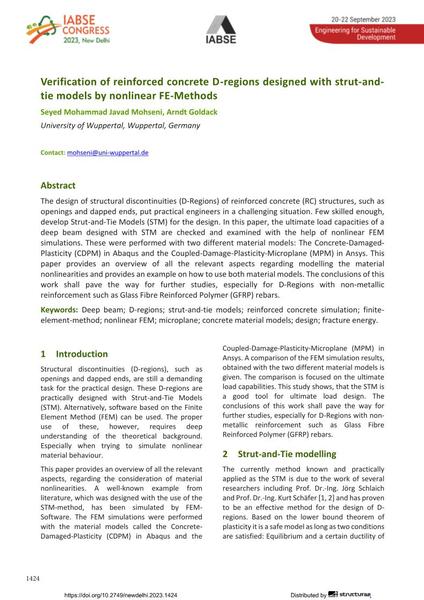Verification of reinforced concrete D-regions designed with strut-and- tie models by nonlinear FE-Methods

|
|
|||||||||||
Détails bibliographiques
| Auteur(s): |
Seyed Mohammad Javad Mohseni
(University of Wuppertal, Wuppertal, Germany)
Arndt Goldack (University of Wuppertal, Wuppertal, Germany) |
||||
|---|---|---|---|---|---|
| Médium: | papier de conférence | ||||
| Langue(s): | anglais | ||||
| Conférence: | IABSE Congress: Engineering for Sustainable Development, New Delhi, India, 20-22 September 2023 | ||||
| Publié dans: | IABSE Congress New Delhi 2023 | ||||
|
|||||
| Page(s): | 1424-1432 | ||||
| Nombre total de pages (du PDF): | 9 | ||||
| DOI: | 10.2749/newdelhi.2023.1424 | ||||
| Abstrait: |
The design of structural discontinuities (D-Regions) of reinforced concrete (RC) structures, such as openings and dapped ends, put practical engineers in a challenging situation. Few skilled enough, develop Strut-and-Tie Models (STM) for the design. ln this paper, the ultimate load capacities of a deep beam designed with STM are checked and examined with the help of nonlinear FEM simulations. These were performed with two different material models: The Concrete-Damaged- Plasticity (CDPM) in Abaqus and the Coupled-Damage-Plasticity-Microplane (MPM) in Ansys. This paper provides an overview of all the relevant aspects regarding modelling the material nonlinearities and provides an example on how to use both material models. The conclusions of this work shall pave the way for further studies, especially for D-Regions with non-metallic reinforcement such as Glass Fibre Reinforced Polymer (GFRP) rebars. |
||||
| Mots-clé: |
design
|
||||
